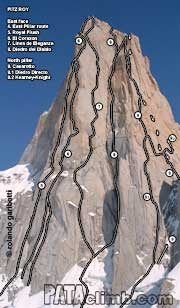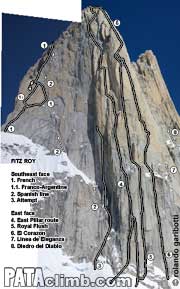Fitz Roy - East face
6. El Corazón
1250m 45˚ 6c A3 M (7b with variations)
Kaspar Ochsner (Switzerland) and Michal Pitelka (Czech), 20/02/1992.
Description. Likely one of the finest rock climbs in the area. With the exception of short sections of flaky rock in the lower third it sports excellent rock. Of the 40 pitches of superb cracks and corners, only nine require aid, eight of which are straightforward C1.
The route climbs a crack line immediately left of a big dihedral, then leads to the center of the snowfields located a third of the way up the face. From there a series of cracks and a short traverse lead to the right flank of a clearly visible tower. The ensuing triple and double crack systems are both climbed by their leftmost cracks, and are incredibly beautiful. The technical crux is overcoming the prominent heart-shaped rock scar that the route is named after, which involves some bat-hooking. Soon after this the route traverses right onto the northeast face, climbing ten pitches of moderate rock and mixed ground to the summit. Each stance was left equipped with two bolts and one carabiner. A very comfortable bivouac exists on top of the prominent tower at the end of pitch 16.
History. It was named after the obviously heart shape feature high up on the route. The first ascent party climbed this route with extensive use of fixed ropes over a two-month period. In late 1987 Inez Bozic, Janez Skok, Gantar Zlate (Slovenia) and Ivo Kafol (Italy) climbed the dihedral just to the right, but were forced to give up their attempt after 350 meters. Further right another line was attempted by Willy Bañales and Jon Lazcano (Spain) in December 1988, but they retreated after four pitches.
In February of 2011, Belgians Nico Favresse and Sean Villanueva complete an onsight free ascent of the upper two/thirds of the route by accessing the obvious snow ledge via the East Pillar route. They found the lower part of El Corazon wet and hence their choice to climb the initial dihedral of the East Pillar. There they found copious amounts of equipment, including long cable ladders that made climbing through "cumbersome" (cable cutters are necessary to remove them). From the end of the obvious dihedral they attempted to continue straight, climbing an impressive splitter only to have it dead end in a slab after a pitch and a half. After backtracking they followed the original line a few more pitches to the snow ledge. Nico and Sean climbed and followed each pitch free and onsight, without jumaring, finding difficulties up to 7b. They started climbing at around 7AM, reaching the top at 11AM on day two after having climbed through the night, with one short brew stop 8 pitches from the top. They bypassed the crux aid section of the route by climbing a long and exposed slab just below it. They described the climbing as being of unbelievable high quality. They descended via Royal Flush.
In 1/2013 Carlos Molina and Iñaki Coussirat (AR) completed the first complete repeat of the route (Nico Fravresse and Sean Villanueva's visionary onsight ascent started by the Ferrari-Meles route just to the left). "Carlitos" logged some flight time in the crux aid pitch and also higher up when he slipped on icy terrain, breaking his ankle. With one of their ropes “dead”, and a broken ankle they descended with the help of Colin Haley and Sarah Heart, who by chance they run into in the summit. Carlitos then hiked out to Rio Blanco on his broken ankle. They bivied twice on the ascent, and once more during the descent.
In early 2016 Jorge Ackermann and Tony McLean completed the first one day ascent, climbing it in 20:30hs. They started at 5AM, reaching the summit at 1:30AM. To avoid the crux aid pitch they made a traverse/pendulum over to the left. Jorge and Tony used doubles to #3 and one #4.
In early 2019, Leo Billon, Max Bonniot and Pierre Labbre (FR) did the fifth ascent of the route. Video here.
Approach. Laguna de los Tres to Paso Superior to Glaciar Piedras Blancas Superior.
Descent. Raps anchors along the route abound, but a descent via the Francesa would likely be more convenient.
Bibliography. Le Alpi 2e/1993 p. 62-72; AAJ 1993 p.182-184; Alp 91 p.20-22; Alp 92 p.28; High 122 p.10-11; Rivista della Montagna 143 p.10-12; Desnivel 73 p.79.
|

